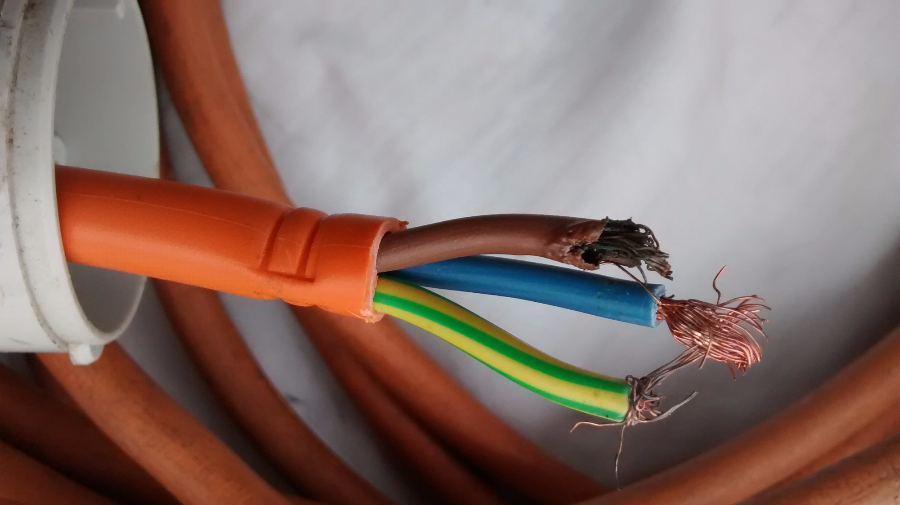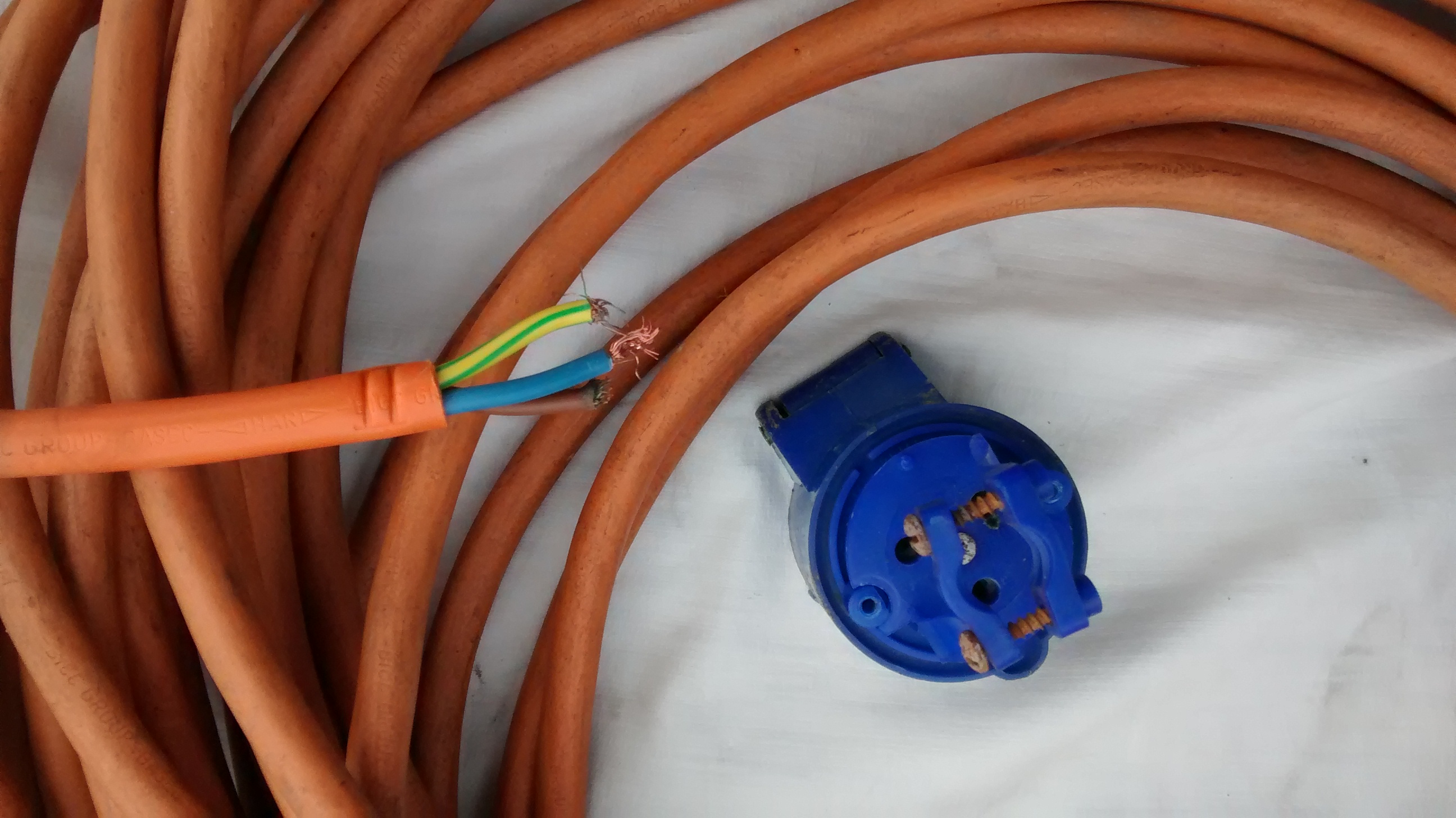Mains Hook-up Cable Considerations.
The quality and condition of the mains EHU affects how things work in the vehicle.

This EHU lead was from my own van, everything worked fine except the Water never got Hot on 230v, it got warm, so the element was clearly working, just never got above tepid. On Gas the water heated up to full temperature.
That shows the type of impact the EHU cable can have. When you need to be on EHU you want to maximise every amp at the Bollard especially if it is s 3amp Site, you might be surprised what part the Hook-up cable plays.
Although Caravan/Motorhome EHU cable is usually referred to as a '16amp' cable, the wire itself is actually rated at 25amp, It is the connectors that are rated at 16amp, if it is BS7671 compliant.
The reason the British Standard for an EHU cable, BS7671, specifies a 25amp cable is for extra safety capacity as well as being physically stronger.. The larger Copper cores result in minimal heating in the cable.
A 'lightweight' EHU Lead made from 16a/1.5mm cores may get significantly hotter than a 25A cable with 2.5mm cores. As the temperature rises, so the resistance increases inflicting a bigger voltage drop.
It is not just about safety but usability, as the correct cable can give more usable power inside the Motorhome.
We recently purchased a 25metre Caravan mains hook-up Lead that was described as 16amp Caravan/Motorhome cable. The cable had undersized 1.5mm cores, when it should have been 25 amp (2.5mm Copper cores) specified by BS7671, so was not up to standard for Motorhomes/Caravans, yet it was advertised as specifically for Motorhomes/Caravans.
There is a lot of this substandard cable being sold.
If the cable is further poorly assembled with loose or poor connections, the impact this will have (apart from it breaching safety regulations) is that the voltage/current drop down a 25metre cable may be significant, meaning that the 230v/16amps power you take from the Site Bollard might be significantly less by the time it gets inside the Motorhome. In other words, the 'extra' imposed by a poor cable might mean that the load being used in the Motorhome results in the Site Bollard being overloaded which then trips out.
In order to prevent the Site Bollard from tripping, the power consumed inside the vehicle might need to be reduced to lower than that expected.
One important point here is that the 16amp Blue connectors used on the thinner 16amp cable are exactly the same as those for 25amp cable, there is only one standard for these Blue Sockets/Plugs.
They obviously have very large 'clamping tubes' for the 25amp/2.5mm Copper strands to fit inside. If you insert thinner 16a cable into these tubes the surface area between the cable and the screw clamp will be reduced with several Copper strands fitting in the 'air' space between the tube and the 'clamping' screw, so not actually in contact with either the screw or Brass tube at all.
Try it, and see just how few Copper strands are actually carrying the power on a 1.5mm core.
A 2.5mm core cable fits snugly inside the connector tube with the clamp screw biting down onto many more Copper strands.
While those savvy with electrics and opting to breach regulations by using thinner cable might double the strands over before inserting the cable and then tightening the clamping screw, the manufacturers who assemble up these 'budget' cables do not.
We have opened 2, neither had a the Copper strands 'doubled over' and both showed evidence of burning and overheating.
If the mains battery charger is a high power 36Amp/12v output unit (about 4 amps in 230v terms) in full flow, subtract it's 4 amps from the 'real' 6amps at the Bollard, to leave just enough power for the Fridge, with little spare for the other 230v items. If the EHU cable itself is 'sapping' some the power it will be worse.
If you happen to be at a site with only 3amp available, you might find that the charger takes so much that the site bollard trips out when you plug in!
If you do have a high capacity or second charger it might be worthwhile turning it off during the day when you require the amps for other things, then back on at night?
To maximise the 'real usable' current in the Vehicle use the shortest, fattest EHU cable you can. If you can get close enough to a site bollard, then use a 10metre lead.
The correct cable assembly should use 16A connectors with 25Amp, 2.5mm cable. The higher resistance and greater frailty (a thinner cable will be weaker) of a 16amp, 1.5mm cable may cause significantly higher heat build up, hence the point of the regulations.
If you have spindly thin 1.5mm cable cores suggest you recycle it

The extra safety levels are probably why we have such things as British Standard 7671, 2001 for Caravan/Motorhome Mains Hook-up Cable, which states :
"For connecting the caravan to the Site socket outlet, a connecting cable is required. This cable must be 3 core 2.5mm², PVC/PVC, flexible cable and 25 metres (+/- 2 metres) in length".
If a cable you are thinking of buying isn't made to BS standard 7671 suggest you put it back?.
The below Caravan Club document covers the regulations very well :

|
Caravan mains electrical Installations BS7671.pdf Size : 353.822 Kb Type : pdf |
A slightly different issue but on the same theme, one Motorhome owner had a Motorhome that tripped out the 230v at home when only a light load was applied. It never tripped when on a site, only at home.
After visiting 3 Dealers and making no progress on the issue he came to us.
Everything checked out in the Motorhome.
Convinced it was a EHU cable issue, we dismantled the EHU cable, which proved to be good.
We then asked how he connected the 16amp EHU to his House electrics, had an electricain fitted a 16a socket and could that be the issue?
Then he showed us a 13a to 16a 'lash up', which hadn't been mentioned before, we straightaway guessed where the problem would be found.
After remaking all the connections and replacing the cheap 13a plug in the 'adapter lead', he had no further issues.
If you have one of these, it has got to be as best as it can possible be, as the 16amps it might asked to pass will be over the rating of the 13a plug and the socket it plugs into.
Better to get a house Sparky to fit a proper 16a socket?